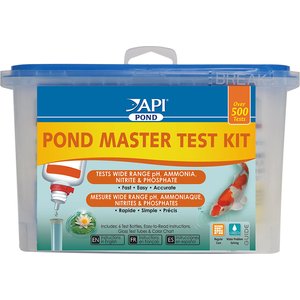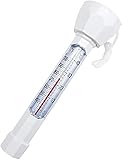How to Keep Pond Fish Alive In Winter (Pond Winterizing Tips)
Pond Academy is reader-supported. Buying through links on our site may earn us an affiliate commission. As an Amazon Associate I earn from qualifying purchases.
Winter can present a few challenges to pond owners…
Especially, if you live in a cold region and have fish.
So, we put together a list of the most crucial pond winterizing tips to ensure your fish have the best chance for survival.
And we also answer many of the most frequently asked questions regarding fish ponds in winter.
This is an important topic, so let’s dive right in.
How Do Fish Survive Winter In Ponds?
Like me, pond fish tend to be less active when it’s cold outside (it’s hard to even get me out of bed in winter). This is because they are cold-blooded creatures whose metabolism takes a drastic dip as the temperature falls.
When this happens, fish reach a state called Torpor. In this resting state, which is somewhat similar to hibernation, your fish heart rates slow down, they require less oxygen and little to no food, and their movement becomes almost non-existent. You’ll typically notice this when temps drop below 45 - 50F.
When your fish are in this state, they also tend to migrate to the bottom of your pond, which is where the warmer water is. As long as your pond water doesn’t completely freeze, certain fish like koi and goldfish will rest in these warmer water pockets and should be able to survive the winter. You can increase the chances of their survival by following the steps in the next section.
![]() Important
Important
Not all pond fish are suitable for the cold-water conditions that winter can bring. Tropical fish, very young fish and non-hardy fish like pleco’s and guppies will need to be brought indoors during winter.
Get Our Best Pond Tips Sent to Your Inbox for Free!
Join thousands of others and learn from our decades of pond building and maintenance experience! Your pond will thank you!
By subscribing you agree to receive emails from PondAcademy.com. We will always respect your privacy and you can unsubscribe at any time.
How To Keep Your Pond Fish Alive In Winter
If you live in a cold region and are concerned about your pond fish dying in winter, then these tips will help ensure their survival.
And again, if you stock tropical fish or very young fish that won’t do well with overwintering, then you’ll need to move them inside.
Fall Clean-up
First things first, we want to make sure the pond is cleaned up before winter hits. This is just good practice whether you have fish or not.
Essentially, you’ll want to clean your pond of any organic debris, like leaves and sticks, dead vegetation, algae, and sludge build-up on the bottom of your pond or water garden. This organic build-up will only consume much-needed oxygen that your pond fish need to survive.
Start by removing visible debris from the surface of your pond with a pond net or pond rake. A good time to do this is after all the leaves have fallen off your trees, this way you should only have to do it once.
Another option is to simply put pond netting over your pond to catch outside debris during the fall months. Then after all the leaves have fallen off your trees, you can just remove the pond net, discard the leaves, and store the net until next fall.
This is also a good time to remove pond sludge that has built-up on the floor of your pond over the summer. This build-up can be particularly bad if you have fish due to excess food and fish excrement sinking to the bottom. The easiest way to do this is with a pond vacuum! In fact, a pond vacuum can do all the above cleaning tasks with ease.
For more tips on how to clean your pond and keep it clean, check out our handy guide on how to clean a pond without draining it (in just 3 easy steps).
After you’ve performed your fall maintenance and have winterized your pond, perform a water quality check to make sure parameters like ammonia, nitrates, nitrites, pond pH and more are in line.
Pond Aerator
Running a pond aerator during the winter months provides several benefits. They are a low-cost alternative to running heaters and de-icers, as the water movement created by an aerator is often enough to keep a hole open in the top of the ice. This helps allow for proper gas exchange (allowing oxygen into the pond while releasing dangerous gases).
Unfortunately, in some regions where it gets particularly cold during the winter months, a pond aerator might not be enough to keep a hole in the ice. If this is the case for you, we’ll want to use a pond heater or de-icer to help ensure a hole is always kept in the icy surface of the pond.
Pond Heater & De-Icer
More expensive to operate than an aerator, but sometimes very necessary, pond heaters and de-icers are designed to keep a hole in your ponds icy surface in frigid climates. There are two main options you have when choosing a heater.
Surface De-icer
A surface de-icer, or floating de-icer, does just as the name implies, it heats a spot on the surface of your pond, essentially keeping a hole in the ice to allow for proper gas exchange. As we discussed above, this will help your fish get the oxygen they need while allowing carbon dioxide to escape.
Submerged Water Heater
Typically, if you’re going to get a heater for your pond, a surface de-icer is the type that you’ll want. However, if you’re worried about the pond freezing completely (or maybe just the water temp dropping too low), you can use a submerged heater.
A submerged heater is placed in the ponds water and helps heat up a pocket of water for your fish.
If you do go this route, measure pond temperature regularly to ensure it's at a sufficient temperature and that the heater is indeed doing its job.
Learn more about floating and submerged heaters, including finding the right sized de-icer for your pond, figuring out the running cost, and more in our guide to pond heaters and de-icers.
If you live in a region where your pond rarely freezes over, we have a guide detailing how to keep a pond from freezing without electricity or any running costs at all that might be worth checking out.
Feeding Schedule
As water temperatures drop and your fish’s metabolism slows down, the less they will eat. It’s very common for fish pond owners to overfeed their fish during the colder months. This just leads to excess food sinking to the bottom, which can hurt your water quality and decrease levels of dissolved oxygen. Not to mention it’s a waste of money.
![]() Tip
Tip
A good rule of thumb is, if your water temps are between 50 and 60F, once a day feedings should suffice. Between 40 and 50F, once every other day. And below 40F you should stop feeding them altogether. If you use a pond fish feeder don't forget to adjust the feeding schedule as the water temperature drops.
As important as the amount of food you give your fish, the quality is equally as important. Be sure to choose a high-quality fish food that is easily digestible. Low-quality foods are not as digestible and are excreted out, which in turn will only hurt the quality of your pond water and reduce oxygen levels.
Pond Depth
The depth of your pond can influence the chance of survival for your koi, goldfish, or other pond fish. Hopefully, this is something you planned for when creating your pond (to save you some work from having to dig deeper later).
So, just how deep does a pond need to be for fish to survive the winter? You’ll read different opinions on the web, but I recommend that a pond be at least 24 inches or 2 feet deep. At the absolute minimum. And we prefer deeper if possible.
Just remember that pond fish need a place deep enough to enter Torpor so they can make it through winter, and if your pond completely freezes solid then your fish will die.
Clean Snow Off The Icy Pond
Oxygen deficiencies are one of the main causes of fish kills during winter. And oxygenating pond plants are a great way to help add the dissolved oxygen necessary for your fish’s survival.
The problem is when your pond is blanketed in snow, the plants don’t get any sunlight. To help alleviate this issue you should remove heavy snow build up from around the edges of your pond to allow sunlight to your plants so photosynthesis can occur.
Just be careful you don’t walk out on to a frozen pond unless the ice is at least 4 inches deep. Safety first!
Daily Pond Checks
If your fish are spending the winter outdoors in your pond, then you’ll want to ensure their health and safety. And though it may seem tedious, it’s a good idea to at least spend a few minutes checking on them daily, if possible.
Don’t expect a lot, if any, movement from your fish during the coldest months. But you do want to check to make sure there is a hole in the ice if your pond’s surface has frozen over. If you’re running a pond pump you’ll want to make sure it’s still operating smoothly.
A daily welfare check doesn’t have to be a long-drawn-out process. A quick and simple check can be the difference between your fish surviving or not.
Can Fish Survive Being Frozen?
No, if your pond completely freezes over your fish will not survive.
Remember, during winter, your pond fish will swim down near the bottom of your pond, where the water is warmer and if cold enough, will enter a resting state called Torpor. While their metabolism may slow dramatically and they don’t eat, they still require dissolved oxygen to survive. If your pond completely freezes over for the winter your fish will not survive.
Can Koi Fish Survive Winter in Outdoor Ponds?
Yes, koi fish (and goldfish) are extremely hardy fish and can survive winter in outdoor ponds with water temps down to 32F. In fact, as long as the water in your koi pond doesn’t completely freeze solid and the water quality and oxygen levels are adequate, then your koi fish should survive.
Should I Cover My Pond In Winter?
While it’s not usually necessary to cover your pond in winter, there are several reasons that many pond owners choose to do so, including:
- A pond cover can help keep debris from entering your pond during the winter months, and potentially be trapped under the frozen ice, where it can add to your ponds sludge problem and potentially reduce oxygen levels.
- They can be used to trap heat under the cover, which can be especially useful in extremely cold climates.
- A durable cover can help keep predators out of your pond during the winter months when other food sources might be scarce.
While I personally have never seen a pond cover designed for winter use on the market, I have seen people effectively use pool covers, more specifically, solar pool covers, to help heat and protect their ponds in the winter months.
I’d recommend building a lean-to over your pond and placing the cover on top of that.
Should I Run My Pond Pump In The Winter?
If you don’t have any fish in your pond, then it may not be necessary to waste the electricity and time maintaining your pond’s pump during the winter months.
But, if you do have fish, then it may be a good idea to run your pond pump in winter. The benefits of running your pump include:
- Keeping your water circulating during the winter months, which can help keep the surface from completely freezing over.
- Pumping water through a mechanical and biological pond filter will help the quality of your water through the winter months.
- Fountains and waterfalls powered by your pump can help oxygenate the pond water, which will help your fish thrive.
With that said, you’ll need to routinely check your pump and any water features to make sure they haven’t frozen over, damaging them permanently.
![]() Tip
Tip
If you decide to run your pump in the winter months, make sure it is submerged at least 24” under the winter to help prevent it from freezing.
Just keep in mind, if temps regularly fall below freezing you run the risk of damaging your pump.
If you decide to remove it for winter, then be sure to store it indoors in a bucket of water. This will prevent the seals from drying out and cracking.
Do Pond Fish Need Feeding In Winter?
It depends on the water temperature. Use this table as a rough guide to feeding your fish in winter.
| Temperature | Feedings |
|---|---|
| Above 60F (16C) | Up to 5 times a day |
| 50 – 60F (10 - 16C) | Once a day |
| 40 – 50F (4 – 10C) | Once every other day |
| Below 40F (4C) | Do not feed |
Notice that below 40F you should stop feeding your fish. This can be hard to do for newer fish pond owners. However, even if you get the urge to feed them, it’s not necessary.
So, when do you start feeding pond fish again after winter? As the temps rise, continue to follow the above chart. For example, once temps rise to over 40F, then start introducing food again roughly every other day. Continue to follow the chart as the weather changes and the temp's rise.
And when you do feed your fish, it’s equally important to use a high-quality fish food like Kaytee Koi’s Choice Premium Fish Food.
How Do I Keep My Pond Fish Warm In The Winter?
You can keep your pond fish warm in the winter by using a pond heater. However, the costs of running a pond heater all winter long can be high and it’s usually unnecessary.
As long as your pond is deep enough to have a place for your fish to enter their “resting” state during winter, and you keep a hole in the icy surface of your pond, they should be fine in the cold water.
With that said, if you live in an extremely cold region and/or want to reduce the shock that extremely cold water temps can have on your fish, you can use a submerged water heater to keep an even water temp for your fish during the colder months.
Just be sure to check that the heater is operating correctly on a regular basis.














